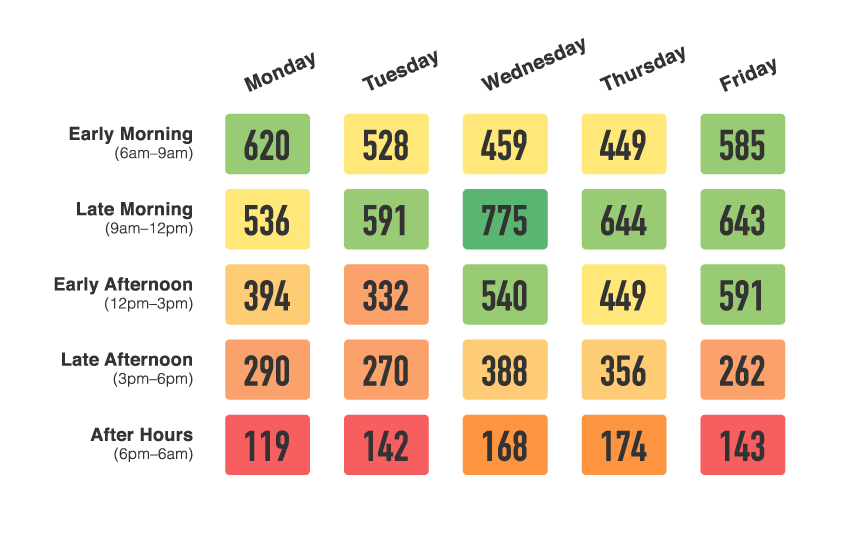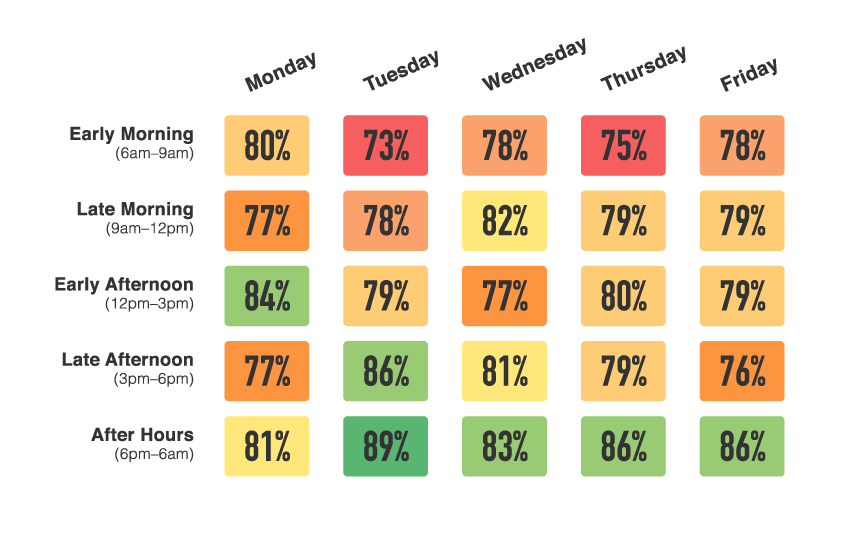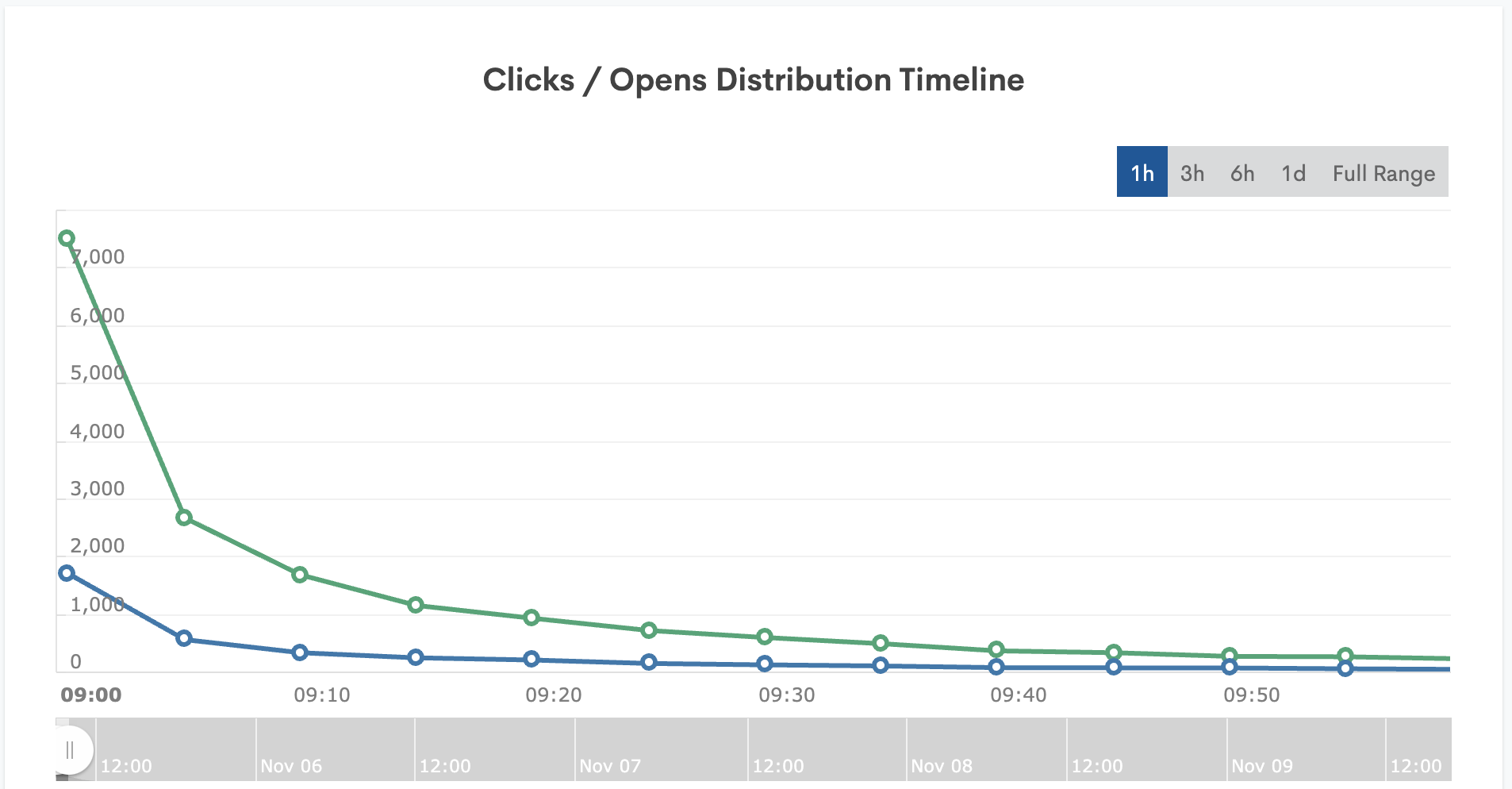If you’re looking for the best time to send an internal employee email, you have about a billion articles out there with research-backed insights on optimal send times. There’s just one problem — all of their research focuses on marketing emails, not internal employee emails.
We’ve reviewed studies from Hubspot, Coschedule, and other popular marketing platforms. They all have excellent data on the best time to send email for marketing, but can these findings be applied to internal email?
We’re all for communicators hopping on the marketing bandwagon and trying out marketing tactics to increase engagement and improve the quality of their content. When it comes to crafting your internal email strategy, though, should you be making assumptions based on this marketing data?
We decided to put these marketing studies to the test and compare them with our own research on internal email interactions to find out once and for all.
Our research is based on over 26 million interactions with internal emails from our system. We were able to capture when emails were sent, the engagement levels they were seeing, and some surprising trends.
Why does send time matter?
You’ve probably heard that you should never send an internal email on a Friday afternoon. Or maybe you’ve been told that the worst time to send something you want employees to act on is during their first hour back at work on a Monday morning.
But how true are these claims?
Most email opens happen within the first hour of the email arriving in an inbox. However, if you send at an inopportune time, employees might open your email — but not have time to engage or respond.
Your email also might get buried during the day, when employees are focused on more pressing issues. Despite their best intentions to open it and respond, your email could be put off and forgotten.
Our research
When are internal communicators sending the most emails?
First, we wanted to establish a baseline, so we looked at when internal comms folk using Staffbase Email were sending the most email.
Here’s how many internal emails were sent at different times throughout the average workweek:

The highest number of emails were sent in the middle of the week — Wednesdays between 9:00 a.m. and 12:00 p.m.
But there were also comparable spikes in sending for late morning each day of the week (except on Mondays, where early morning sending between 6:00 a.m. and 9:00 a.m. was most popular). However, some research suggests that sending marketing emails early Monday morning leads to poorer email performance because people are feeling overwhelmed by the bombardment of emails that accompany the start of their work week.
And contrary to the internal comms wisdom floating around, we were also surprised to see a lot of internal emails sent on Fridays.
Otherwise, the data we captured aligns pretty well with the research we found about the best time to send marketing emails, which generally recognizes late morning midweek (Tuesday through Thursday) as the best time to send an email if you want it opened and read.
Bottom line: Internal communicators seem to be sticking to schedules similar to marketers when it comes to sending employee emails. However, because of conflicting research, it’s hard to say if this is a good thing or a bad thing.
But these are just when internal employee emails were being sent — not when they were opened or how well they performed. We’ll take a look at that next.
How does send time affect internal email open rates?
We looked at the same set of emails and discovered the average open rate that emails sent at each time achieved:

The average open rate for internal emails sent during working hours was 79% (which blows marketing email open rates straight out of the water, by the way). Across the board, results were fairly close to this average, with high points on Monday and Tuesday afternoon.
We also noticed that there were slightly higher open rates for emails sent earlier in the week (Monday through Wednesday). But those emails sent on Friday still performed well on average — achieving open rates of almost 80%.
Why are open rates so similar?
You probably noticed that the day-to-day and time-of-day variance in the data represented above isn’t too drastic. For example, there is only a 7% difference in opens for emails sent early morning across the week, and even less of a difference between emails sent at other times of day across the week.
So does it really matter when you send?
When it comes to internal emails, most people will eventually open them if they are important and relevant — though some opens and clicks will be delayed (because life happens, too).
And even though a 7% difference in opens across the week — or 16% opens difference between times of day — doesn’t seem like a lot, on a list of 1,000 employees that means the difference of 160 more people reading the email. That’s quite a few people.
Should you send internal employee emails after hours?
We also observed higher than average open rates for emails sent after hours (between 6 p.m. and 6 a.m.).
But does that mean you should be sending emails to employees after hours?
Popular marketing research says these are some of the best times to send emails for opens and replies because there’s less competition in the inbox and people have more time to respond. Even if that’s the case, we are hesitant to recommend this tactic for employee emails.
There are plenty of good reasons not to send emails to employees after normal work hours. Namely, people need time off to not think about work — research shows work emails can be a significant source of stress.
It’s important to think about what kind of culture you’re looking to cultivate, as well as your email policy. For example, just because an email was sent after or before normal work hours, it doesn’t mean it was opened at the same time. If your employees aren’t inclined to check their emails after work hours, it might make sense to schedule emails before people start their day. Being the first email in the inbox before other emails trickle in could pay off.
And if your organization has offices or remote workforces in different time zones, you should also consider when it’s most appropriate to send an email. If a message is meant for your New York office, but you’re based in Singapore (and 13 hours ahead), then schedule your communications based on the optimal time for your American colleagues.
Using your internal email data to find out the best time to send emails
You can sift through as much external data as you want, but the best time to send internal emails in your company can only be revealed by your own data. That’s because data gives you insight into what strategies and tactics work best for your internal comms.
Long story short: you should make decisions based on your internal email data.

Ways to increase opens and clicks on internal email
Let’s say you’ve found the day and time with the highest opens and engagement rates for your company. And you’re a bit disappointed. It turns out that even at your peak days and times, you still aren’t getting the open numbers you were hoping for.
The first and easiest thing you can do is set a regular delivery schedule. If employees know that there is a company newsletter that comes every morning at 9:05 a.m., they will come to expect it. And if the newsletter is chock-full of important information for their day or week, employees will budget the time to read the newsletter.
The second thing you can do is maintain an editorial calendar. This will help you figure out when you should be sending emails throughout the week or month, so you can avoid bombarding employees with emails. An organized editorial calendar is an essential piece of a good strategy because it respects employees’ time, energy, and workload.
When is the best time to send internal emails?
So after all the data was gathered, what did we discover is the best time to send internal emails?
We know you aren’t going to like this, but it’s the truth:
It depends.
There are a number of factors that all need to be weighed in order to pick the best time for your company. And as much as we would love to give you a blanket statement about what time of day or week is best, it won’t be much help if you aren’t also considering the following:
1. Your audience
Is your workforce desk or non-desk-based, hybrid, remote, or on the road? Do they have regular time to check their emails? Do they work normal hours and work weeks or do they have rotating shifts or desk time? Do employees in your company or industry send and receive a lot of emails? Are they accustomed to receiving emails throughout the day?
Further, are they segmented? Do they work in different time zones that need to be taken into account?
2. Your goals
Do you just want employees to read the email, or do you want them to respond or click?
Are you trying to engage employees and cultivate a particular culture, or are you trying to communicate policy change or company-wide initiatives?
3. Your culture
Does your company make work-life balance a priority? Then it might be contrary to your company culture to be sending emails after hours and expect responses or engagement.
On top of that, how many emails are you sending? Are you sending once per week, or once per month? Or are you sending multiple emails per week? What kind of emails are you sending?
Conclusion: It depends.
Your audience, goals, and culture should all inform your email strategy and when you choose to send employee emails.
Timing your emails thoughtfully is a good way to show that you are cognizant of your employees’ needs, time, and workflow while increasing clicks, opens, and — most importantly — engagement.
And though there is a lot of information out there about the best time to send marketing emails, we’ve found it doesn’t exactly apply to internal employee email. The only way to find out the best time to send internal emails for your company is to evaluate your own open and click rate data.
Staffbase makes scheduling and measuring employee emails super easy. Start collecting your data with Staffbase and you can find out once and for all the best time to send emails to your employees.



